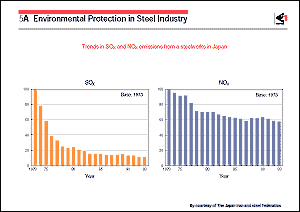The main problems of the global
environment presently include destruction of the ozone layer,
acid rain, global warming, decreases in tropical rain forests,
and desertification. Industrial development in line with economic
expansion and population growth in the latter half of the 20th
century has been the fundamental cause of these problems, although
in many ways the cause-and-effect relationships are still not
completely clear. The main global environmental issues related
to the steel industry are acid rain and global warming.
Acid rain is attributed to emissions of sulfur oxides (SOx)
and nitrogen oxides (NOx), and it
has therefore become important to limit the emissions of these
oxides.
Of the sulfur oxides, sulfur dioxide (SO2)
is produced by the combustion of petroleum or coal which contains
sulfur, and can cause both acid rain and respiratory ailments
when its concentration is high. In 1973, the environmental standard
for SO2 in Japan was set at below
0.04 ppm as a daily average value. In steel works, sulfur oxides
originate mostly from the sintering machines, coke ovens, and
reheating furnaces. Various countermeasures have been taken to
remove sulfur oxide, including desulfurization of the exhaust
gas from the sintering machines and coke oven gases, and the
use of low-sulfur coals and fuels. Consequently, the sulfur oxide
emissions from steel works have decreased greatly, as can be
seen from the left side of the figure. In the whole of Japan,
the concentration of sulfur dioxide (SO2)
has registered a flat yearly average of 0.01 ppm since 1986.
Nitrogen oxides are produced when nitrogen in the air and in
fuel is oxidized at high temperatures, and is generated mainly
by burning fossil fuel. Of the nitrogen oxides, nitrogen dioxide
(NO2) in high concentrations has a
harmful effect on the respiratory organs and is one of the harmful
substances in acid rain and photochemical air pollution. In 1978,
the environmental standard for NO2
in Japan was set at below 0.06 ppm as a daily average value.
The sources of nitrogen oxides in steel works are similar to
those of sulfur oxides, being the sintering machines, coke ovens,
and reheating furnaces. Various measures have been taken to eliminate
nitrogen oxides, including (i) the development of burners which
reduce the generation of nitrogen oxides, (ii) improvement of
combustion conditions, and (iii) the development and installation
of de-NOx equipment which removes
nitrogen oxides from the exhaust gas. Consequently, as can be
seen on the right side of the figure, the emission of nitrogen
oxides from steel works is continuing to decrease. In the whole
of Japan, the yearly average concentration of nitrogen dioxide
(NO2) is around 0.03 ppm as measured
at the generic environment monitoring stations and around 0.04
ppm at measuring stations for monitoring automobile exhaust gas.
The SO2 and NO2 emissions form the steel works have not been registered by The Japan Iron and steel federation since 1994. In recent years the steel companies are disclosing their indivdual emissions in their publication such as "Annual Report on Environmental Protection". According to those the emissions in 1994 - 2000 remains almost unchanged as in 1990 - 1993. |
|
 |
 |
 |
|
|